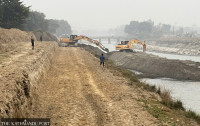National
Nepal and India to explore potential of more high-capacity electricity transmission lines
The move comes on the heels of the signing of a long-term agreement under which the southern neighbour will buy 10,000MW electricity in 10 years.
Prithvi Man Shrestha
With India promising to buy 10,000MW power in 10 years under a long-term agreement, Nepal and India have agreed to study the possibility of constructing new high-capacity transmission lines.
The two sides also agreed to conduct a study on optimising the existing and under-construction cross-border transmission lines. On January 4, the two countries signed a long-term power trade agreement during the visit of Indian Foreign Minister S Jaishankar. The deal was initiated during Prime Minister Pushpa Kamal Dahal’s visit to India in late May and early June last year.
During the 11th secretary-level meeting of the Joint Steering Committee (JSC) held on January 5, the two sides reached a number of agreements on transmission connectivity to boost power trade between the two countries.
According to a statement by the Ministry of Energy, Water Resources and Irrigation, the Joint Technical Team (JTT) of the JSC was ordered to carry out the study on the new high-voltage cross-border transmission lines required to boost power trade between the two countries.
“The two sides have agreed to carry out a study on the possibility of constructing at least three new cross-border power lines,” said Dirghayu Kumar Shrestha, chief of the transmission directorate at the Nepal Electricity Authority (NEA), namely Lamahi (Dang)-Lucknow (Uttar Pradesh), Nijgadh (Bara)-Motihari (Bihar) and Anarmani (Jhapa)-Kishanganj (Bihar).
He said that besides these proposed cross-border lines, the JTT could also study other potential projects. “We have proposed a study on the feasibility of these three projects,” Shrestha said.
Currently, the 400kV Dhalkebar-Muzaffarpur Cross-border Transmission Line is the only high-capacity line between the two neighbours that can transmit up to 1000MW of power. There are about a dozen cross-border power lines, all of them low-capacity ones.
Other four high-capacity cross-border transmission lines are in the pipelines.
The SJVN Arun-3 Power Development Company, the developer of 900MW Arun 3 Hydropower Project, has been constructing 400kV Dhalkebar-Sitamarhi line to carry up to 2,000 MW.
Likewise, construction of the New Butwal-Gorakhpur Transmission Line, which will be able to supply up to 3,500MW, has also begun following the laying of the foundation stone of this project when Prime Minister Dahal visited New Delhi.
The two countries also agreed to develop the 400kV Inaruwa (Duhabi-Purnia, Bihar) and the 400kV New Lamki (Dodhara-Bareli, Uttar Pradesh) cross-border lines by 2027-2028 and 2028-2029, respectively.
“As India has promised to buy 10,000MW in 10 years and we also plan to export power to Bangladesh, we need to explore the possibility of constructing more cross-border power lines,” said Shrestha.
Besides agreeing to explore the potential of adding new high-capacity power lines, the two countries also agreed to carry out a study on how more than 800MW of power could be traded through the Dhalkebar-Muzaffarpur line.
During the 10th JSC meeting held in February, the two countries agreed to increase the volume of power to be traded via the Dhalkebar-Muzaffarpur line from 600 MW to 800 MW.
According to Shrestha, without completing the 400kV Hetauda-Dhalkebar-Inaruwa line, there will be technical difficulty transmitting power in the quantum of 1,000 MW through the Dhalkebar-Muzaffarpur line.
Two sides also agreed to carry out a study through the JTT to determine the actual capacity of the under-construction 400kV Dhalkebar-Sitamarhi cross-border transmission line. Officials said it could transmit upto 2,000MW.
During the 10th JSC meeting, the two sides also decided that Nepal could use the spare capacity of the 400kV Dhalkebar-Sitamarhi cross-border facility being built by the SJVN Arun-3 Power Development Company.
Until the 679MW Lower Arun Hydropower Project and the 490MW Arun 4 Hydropower projects—both with investments of India’s state-owned SJVN Limited—are developed, Nepal can use the spare capacity of the Dhalkebar-Sitamarhi line to trade power from other projects, officials said. The SJVN is the developer of the 900MW Arun 3 project, the construction of which is expected to be completed by 2024.
There has also been an understanding to increase power trade from Nepal’s Far West either by boosting the capacity of the 132kV Mahendranagar-Tanakpur transmission line or with other high-voltage transmission lines. For this, the JTT has been asked to undertake a study, according to the ministry’s statement.
The 10th JSC meeting also instructed the joint secretary-level Joint Working Group to conclude the investment modality for the development of Duhabi-Purnia and New Lamki-Bareli cross-border lines, the ministry said.
The modalities of cross-border power trade through lines of capacity 132kV or lower were approved at the meeting, according to the ministry. “Based on the approved modality, state-level grids of Bihar and Uttar Pradesh can be used for bilateral trade of electricity,” the ministry said.
According to a statement by the Indian embassy, the approval to the modality has significance as three new 132 kV lines—second circuit of Raxaul (Bihar, India)-Parwanipur (Nepal), second circuit of Kataiya (Bihar, India)-Kusaha (Nepal) and New Nautanwa (Uttar Pradesh, India)-Mainhiya (Nepal)—were inaugurated by the external affairs minister of India and the minister for foreign affairs of Nepal on 4 January 2024.
According to the embassy, these lines increase the transmission capacity by about 200 MW, taking the overall capacity for India-Nepal power trade to 1,400 MW. The New Nautanwa-Mainhiya transmission line is the first connection between Nepal and the Indian state of Uttar Pradesh, it said.




 17.12°C Kathmandu
17.12°C Kathmandu















